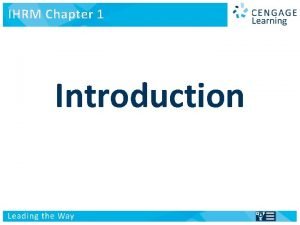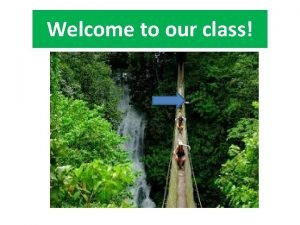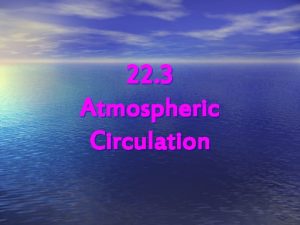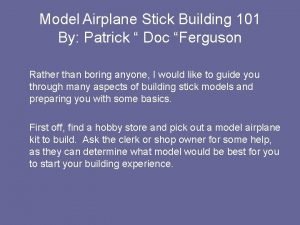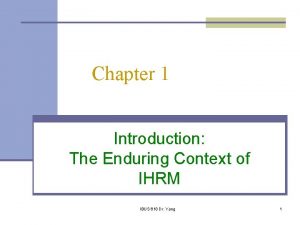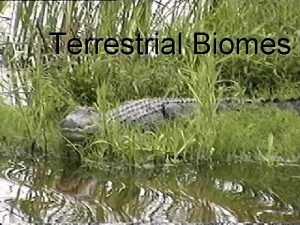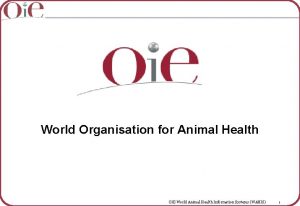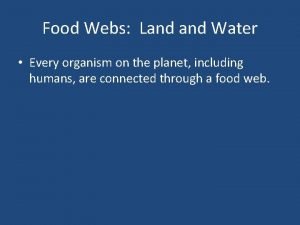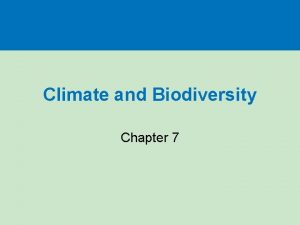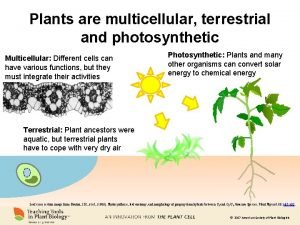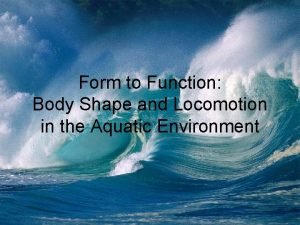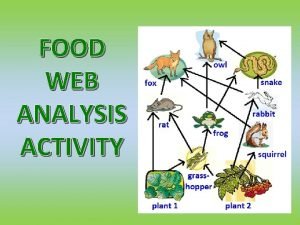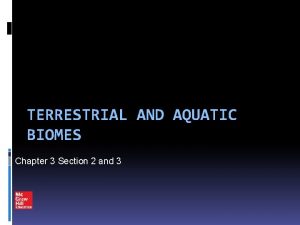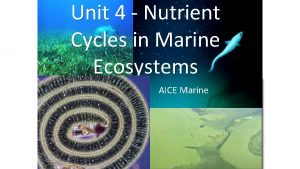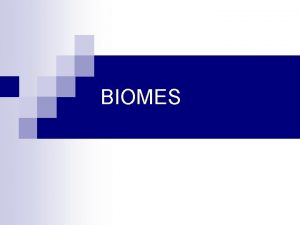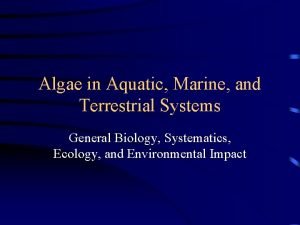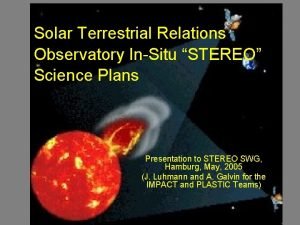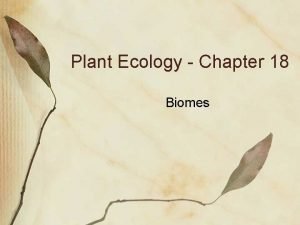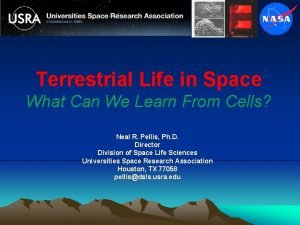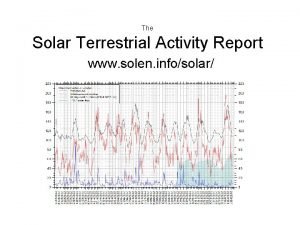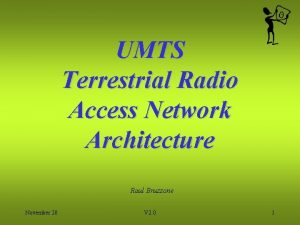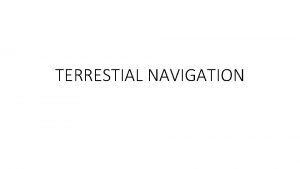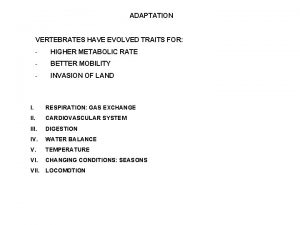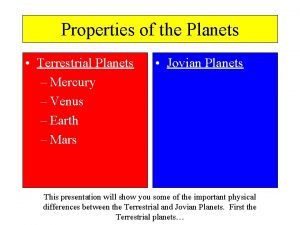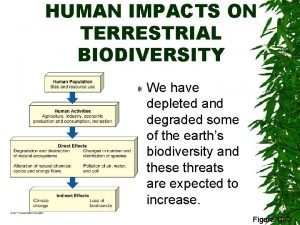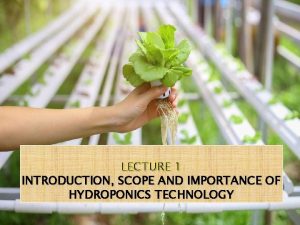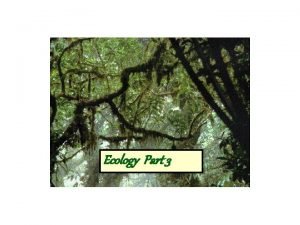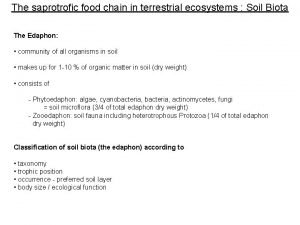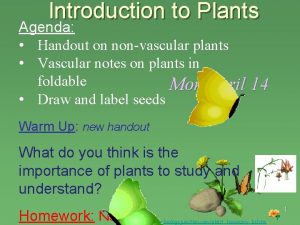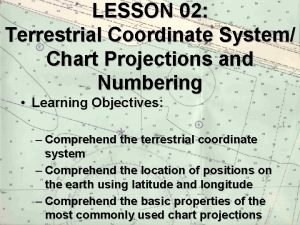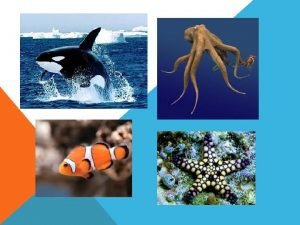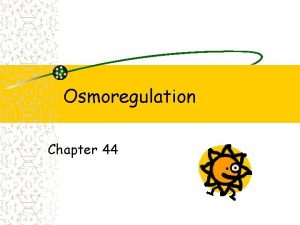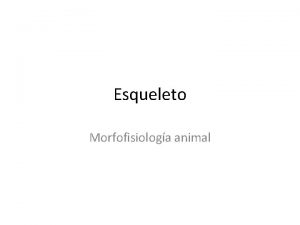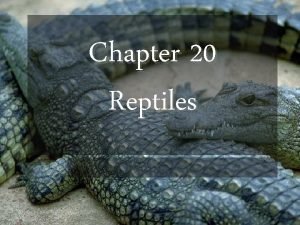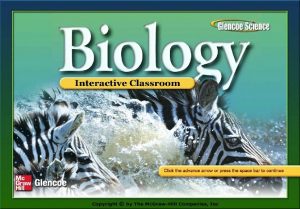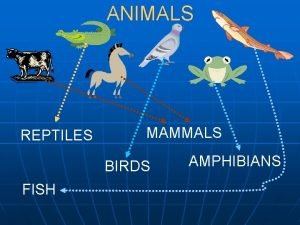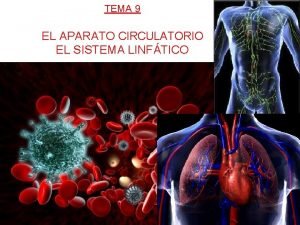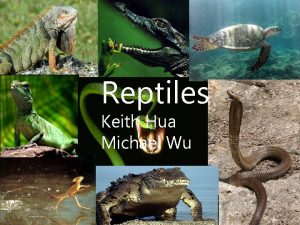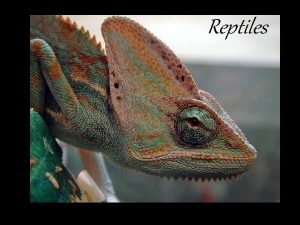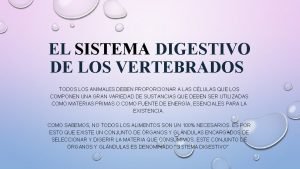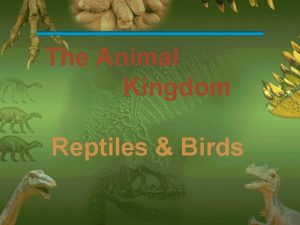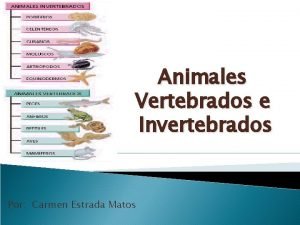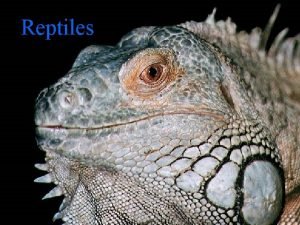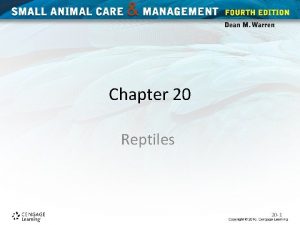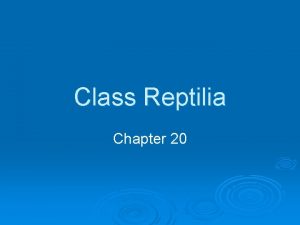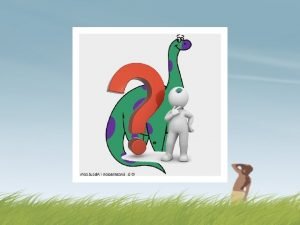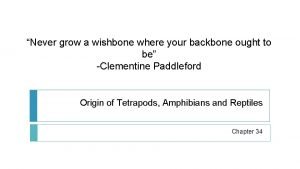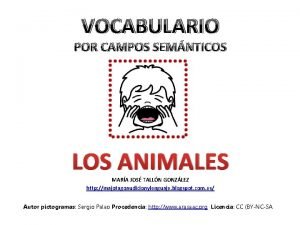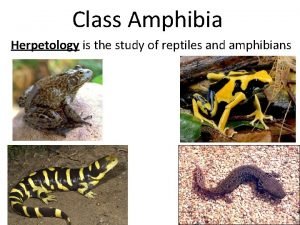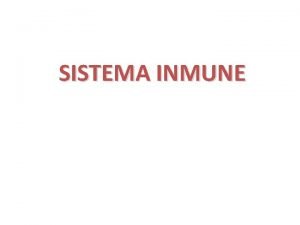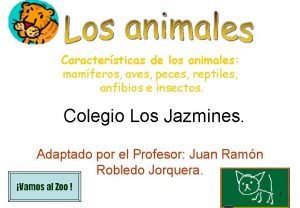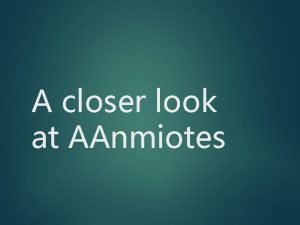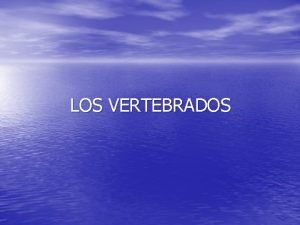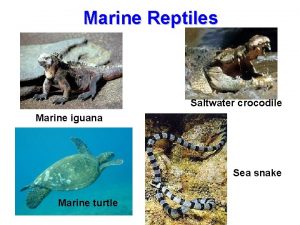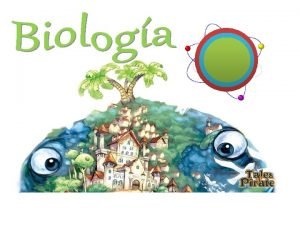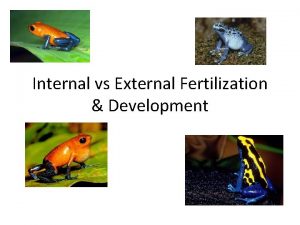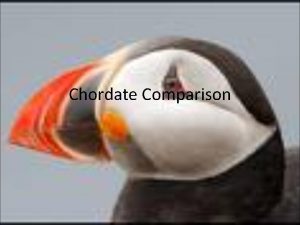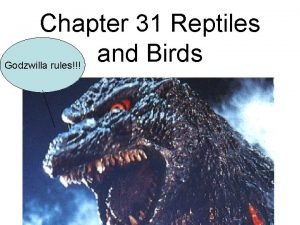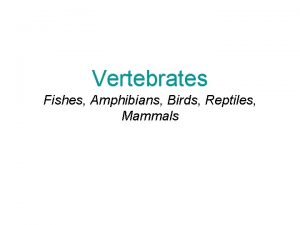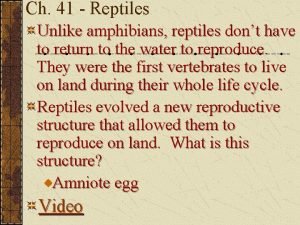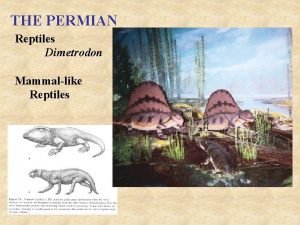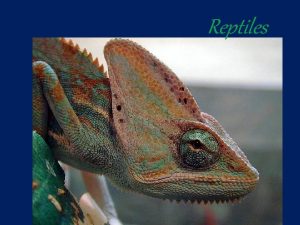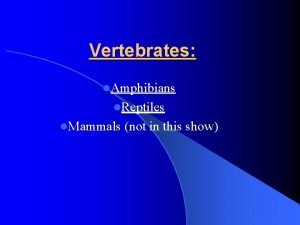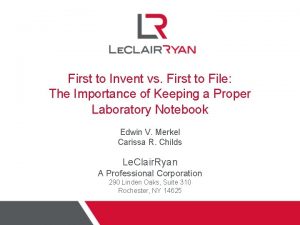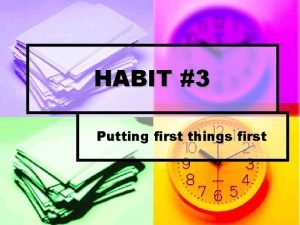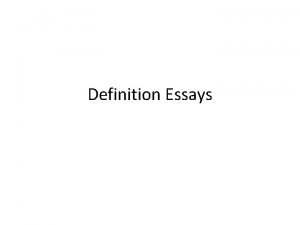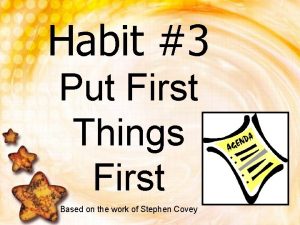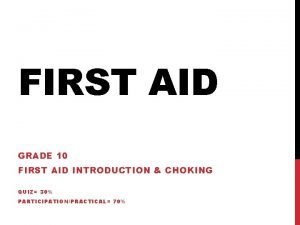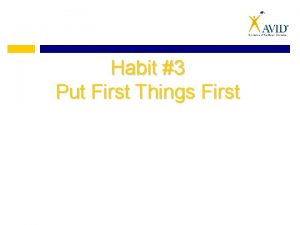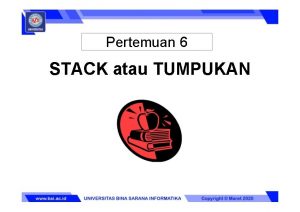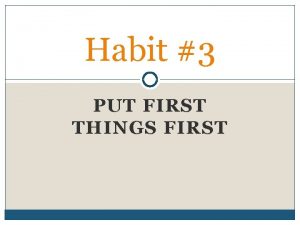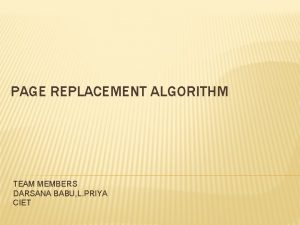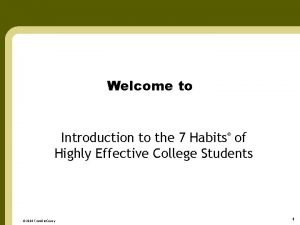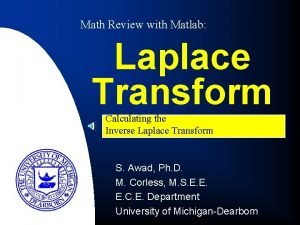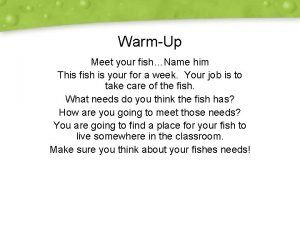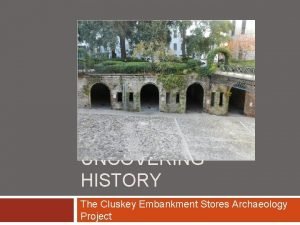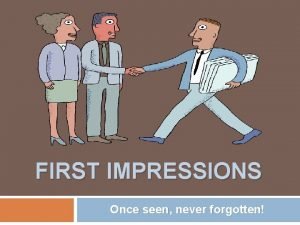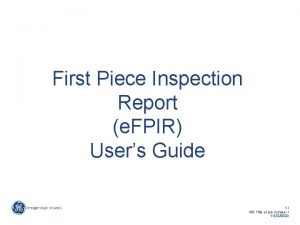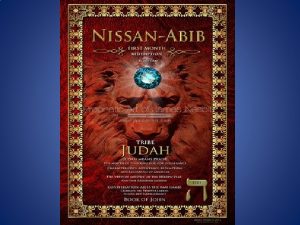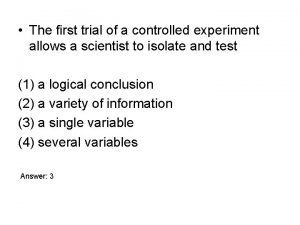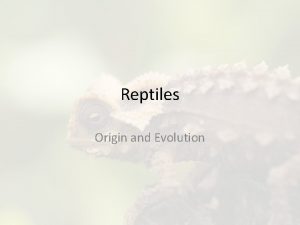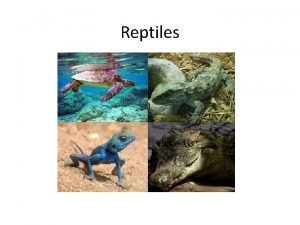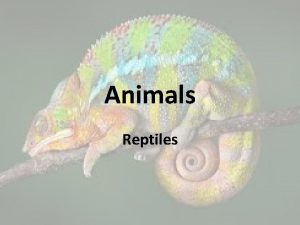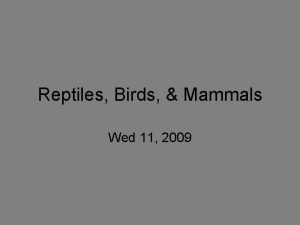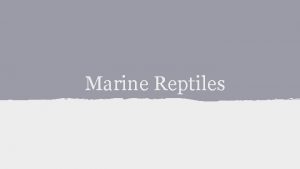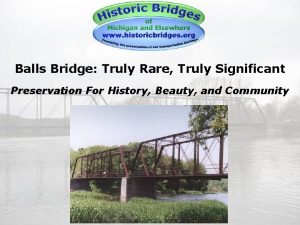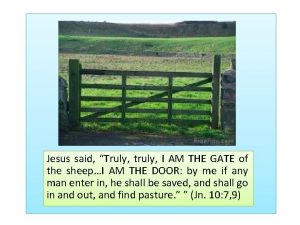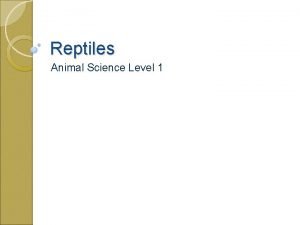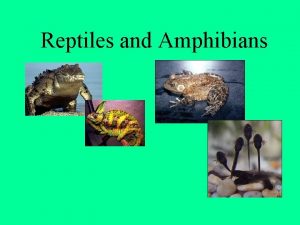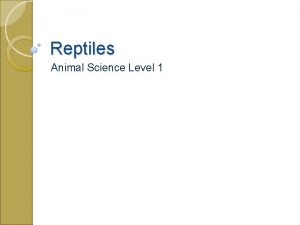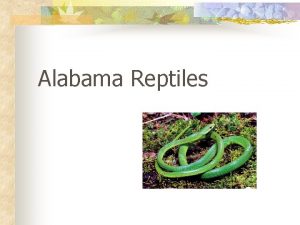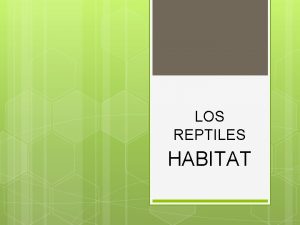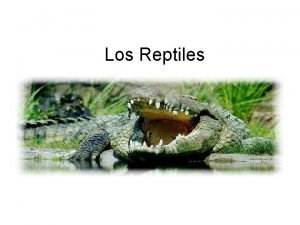Reptiles Reptiles n n n First truly terrestrial

























































































































- Slides: 121

Reptiles

Reptiles n n n First truly terrestrial vertebrates ~7000 species worldwide ~300 species in U. S. and Canada

Reptiles n n n Probably best remembered for what they once were, rather than what they are now Mesozoic era - age of reptiles Dominant group for >150 millions years

Reptiles n n 12 or so principal groups of reptiles evolved Only 4 groups remain today

Order Squamata n n n Snakes and lizards >5800 species Most successful group

Order Crocodilia n n Crocodiles, alligators, caiman ~25 species Have survived for 200 million years Today: concerns that humans may drive them to extinction

Order Chelonia (Testudines) n n n Turtles ~330 species Ancient group that survived, remained mostly unchanged from early ancestors

Order Rhynchocephalia n n n Snout head or tuatara Only 1 species From New Zealand sole surviving species of ancestral stock

Reptilian Characteristics n n Tough, dry scaly skin Protection against desiccation, physical injury Thin epidermis shed periodically Much thicker dermis with chromatophores

Reptilian Characteristics n n n Dermis converted into snakeskin, alligator leather for shoes, purses, and so on Scales of keratin (epidermal) Not homologous to bony, dermal fish scales

Reptilian Characteristics n n Crocodilian scales remain throughout life Grow gradually to replace wear

Reptilian Characteristics n n In snakes and lizards, new scales grow beneath old Old scales shed with old skin

Reptilian Characteristics n Turtles add new layers of keratin under old layers of the platelike scutes (modified scales)

Shedding n Snakes turn old skin (scales, epidermis) inside out when shedding

Shedding n Lizards split skin and leave it right side out, or slough it off in pieces

Amniotic Egg Chorioallantoic membrane

Amniotic Egg n n Reptiles are able to lay their eggs in sheltered locations on land Young hatch as lungbreathing juveniles, not aquatic larvae

Amniotic Egg n n Amniotic egg widened division between amphibians and reptiles Probably greatly contributed to decline of amphibians and rise of reptiles

Reptile Jaws n n n Reptile jaws designed for crushing prey Fish, amphibian jaws designed for quick closure, but little force after Reptile jaw muscles larger, longer, arranged for better mechanical advantage

Reptile Copulatory Organ n Copulatory organ permitting internal fertilization Internal fertilization required for a shelled egg Copulatory organ formed from an evagination of cloaca

Reptile Circulation n More efficient circulatory system, higher blood pressure All reptiles have at least an incomplete separation of the ventricles Flow patterns prevent mixing

Reptile Circulation n n Crocodilians have two completely separated ventricles All reptiles have two functionally separate circulations

Reptile Lungs n n n Improved lungs Depend almost exclusively on lungs for gas exchange Supplemented by pharyngeal membrane respiration in some aquatic turtles

Reptile Lungs n n Lungs have larger respiratory surface than in amphibians Air sucked into lungs rather then forced in by mouth muscles Negative pressure Skin breathing completely abandoned

Reptile Kidney n n Kidneys more advanced (metanephric) Very efficient at conserving water Excretes uric acid (rather than urea, ammonia) A semisolid paste

Better Body Support n n n Limbs better design for walking on land More ventral, less lateral Many dinosaurs walked on only hindlimbs

Nervous System n n Much more advanced - relatively larger cerebrum CNS connections more advanced - permit complex behaviors not found in amphibians

Nervous System n Sense organs generally well-developed

Order Chelonia n n n Turtles Very ancient group Little change in morphology since Triassic period

Order Chelonia n n n Body enclosed in shell Dorsal carapace Ventral plastron

Order Chelonia n n n Thoracic vertebrae and ribs built into shell Shell of two layers Inner of bone Outer of keratin New keratin deposited under old as turtle grows, ages

Order Chelonia n n Jaws lack teeth Equipped with tough, horny plates for gripping, chewing food

Order Chelonia n n n Respiration poses a problem Shell prevents expansion of chest for breathing Adapted to use certain abdominal, pectoral muscles as a “diaphragm”

Order Chelonia n n Air drawn in by contracting limb flank muscles to make body cavity larger Exhalation also active - shoulder muscles contracted, viscera compressed, air forced out of lungs

Order Chelonia n n Deformable plastron in snappers allows some elastic recovery during exhalation Compressive force of water against body also can force air out

Order Chelonia n n Many water turtles acquire enough O 2 when inactive by pumping water in and out of mouth Pharyngeal breathing Can stay submerged for extended periods Must lung breathe more frequently when active

Order Chelonia n n Nervous system - tiny brain Typical of most reptiles Never exceeding 1% of body weight, but cerebrum larger than in amphibians Turtle can learn, as quickly as a rat, to run a maze

Order Chelonia n n n Have both middle & inner ear, but sound perception is poor Turtles are virtually mute Tortoises may grunt or roar

Order Chelonia n Poor hearing compensated for by: n n n Good sense of smell Acute vision Color perception as good as that of humans

Order Chelonia n n n Mating & reproduction Many varieties of courtship Males of aquatic species may swim around looking for proper leg stripe pattern Pheromones also Males use claws

Order Chelonia n n Terrestrial species may vocalize Males may track females (pheromones) for days

Order Chelonia n n Males may mark territory with fecal pellets Courtship involves rubbing limbs against scent glands (underside of jaw) and sniffing

Order Chelonia n n Biting, ramming, hooking are directed at other males Biting - head & limbs Ramming - rearing up, smacking shells Hooking - bulldozing under plastron to flip or hurry

Order Chelonia n n n Turtles are oviparous Fertilization is internal, and all species bury eggs in ground in nests 4 to >100 eggs

Order Chelonia n n Exercise care in constructing nest Deposit eggs and abandon them Incubation 1 -14 months 40 -60 days most typical

Order Chelonia n n n Movements to nesting areas very faithful Terrestrial species use familiarity with area, sun Marine species use variety of mechanisms to traverse large distances

Order Chelonia n n n Earth’s magnetic field Polarized light Sun & stars Low frequency sounds Green sea turtles find Ascension Island (20 km) in mid-Atlantic from coastal Brazil - 2200 km

Order Chelonia n n Size - marine turtles largest Buoyed by aquatic environment May reach 2 m in length, 725 kg in weight Biggest species is leatherback

Order Chelonia n n Green sea turtle may exceed 360 kg Economically valuable - heavily exploited rarely gets to large size

Order Chelonia n n n Land tortoises generally not as large as aquatic forms Some may weigh several hundred kg Giant tortoises of Galapagos Islands among world’s largest terrestrial turtles

Order Chelonia n n n Lifespan - turtles are most long-lived vertebrates Individuals of at least 5 species known to live 100 years or longer Some believed to have lived more than 150 years

Order Chelonia n n n Longevity attributed to slow rate of metabolism Galapagos tortoise top speed: 300 m/hr Reports of box turtle caught in U. S. with “ 1850” carved into plastron n Skepticism!

Order Chelonia n n n Protective shell Head, appendages can be drawn in for protection Box turtles especially good because of hinged plastron

Order Chelonia n n Shell not as protective in many species Soft, leather-like in softshell turtles

Order Chelonia n n n Shell too small for protection in other species, e. g. , snappers Other means of defense - ferocious, short-tempered “Tigers of the pond”

Order Chelonia n n n Entirely carnivorous fish, frogs, ducks, whatever they can catch Alligator snapper hides on bottom and waves worm-like tongue to attract fish Wholly aquatic - come ashore only to lay eggs

Turtle Conservation n n Slow growth, long time to maturity predispose many species to risk of extinction Changing conditions may increase adult mortality, juvenile recruitment

Turtle Conservation n Problem severe for large tortoises, sea turtles Largest, slowestgrowing Human and animal invasion of beaches, isolated island habitats

Turtle Conservation n n Herbivores compete with tortoises for limited vegetation Eggs, young fall prey to dogs, cats, rats

Turtle Conservation n n Protection of land tortoises simpler than protection of sea turtles Limited range (single island) defines limits where protection is needed

Turtle Conservation n Sea turtles range over international, national borders Limited number of breeding sites Problems with exploitation controlled or outright ban?

Turtle Conservation n Ocean plastics pollution - bags look like natural jellyfish prey Not enough known about biology do devise protective management program Tag a turtle? 2000 X







Order Squamata n n “characterized by scales” Lizards, snakes, worm lizards Most recent products of reptile evolution Most successful 95% of known living species of reptiles

Order Squamata n n n Lizards began diversifying at time when dinosaurs were near end of their dominance Were successful because of adaptability Adopt various body forms, occupy various habitats

Order Squamata n Snakes likely arose from group of lizards whose descendents include monitor lizards, but fossil record poor

Order Squamata n n Legless character apparently evolved as adaptation to burrowing lifestyle Snakes since have radiated into terrestrial, aquatic, arboreal niches

Order Squamata n n n Two adaptations characterize snakes: Extreme body elongation displacement, rearrangement of organs Highly mobile jaws swallow prey larger than own diameter

Order Squamata n Two suborders: n Sauria - lizards n “lizard” n Serpentes - snakes n “to creep”

Lizards n n n Very diversified group (3300 species) Terrestrial, burrowing, aquatic, arboreal, aerial Many familiar groups:

Lizards n Geckos n Mostly small, nocturnal, with adhesive toe pads (walk anywhere)

Lizards n Iguanas n Often bright-colored New World lizards n Marine iguana - only marine lizard in world

Lizards n Skinks n Elongate bodies, reduced limbs

Lizards n Chameleons n Arboreal n Tongue flicked to greater distance than body length Prehensile tail Zygodactylous feet n n

Lizards n Independently moveable eyes elevated on cones good eyesight - gauge distance accurately

Lizards n n n Lizard body form not as distinctive as other reptiles Many functional, behavioral modifications e. g. , degenerate or absent limbs - no good in dense grass

Lizards n Differ from snakes: n Halves of lower jaw firmly united at mandibular symphysis n Teeth, but not developed into fangs

Lizards n Moveable eyelids (snake eyes covered with permanent, transparent cap) n Keen daylight vision

Lizards n Size - 3 cm to 3 m n Hawaiian gecko n n Komodo dragon 75 kg n Fossils: 5. 5 m, >1000 kg

Lizards n n n 80% of lizards are <20 g in weight Generally insectivorous (opportunistic), although some specialists N. Amer. horned lizards eat only ants

Lizards n n Most large lizards are herbivores Trees in tropics, ground vegetation on oceanic islands, seaweed in ocean

Lizards n n n Monitor lizards are exception to vegetarians Food of vertebrates (birds, mammals), invertebrates Komodo - ambush predator on large mammals (deer, goats, water buffalo)

Lizards n Foraging strategies: n Sit and wait (insects come to them) n Active foragers (move to encounter prey)

Lizards n n n Foraging modes alternate at successive levels of food chain Moving insect -> sitand-wait lizard -> active predator Sitting insect -> active lizard -> sit-and-wait predator

Lizards n n n May use territorial and courtship behaviors Male anoles have gular fan (dewlap) for conspicuous displays Skin distended by hyoid apparatus

Lizards n Behaviors include: n Extending, contracting fan Pushups Bobbing head n n

Lizards n n n Territories defended by males for access to females (bite & chase, but no fighting) Females have nonoverlapping home ranges for feeding Male territory includes several females mates with all

Lizards n n n Mate by pressing cloacal regions together Males grip female’s neck, shoulders Males have paired copulatory organs hemipenes - to aid sperm transfer

Lizards n Range of reproductive modes from oviparity to viviparity n Skinks - eggs retained in oviducts, receive nutrients across a “placenta”

Lizards n n n All-female (parthenogenetic) species occur in at least 6 families Especially common among racerunners (Teiidae) Diploids and triploids known

Lizards n n High reproductive potential - every individual capable of producing offspring Can repopulate habitat faster than bisexual species after flood, other disaster

Lizards n Parental care n Many lizards remain with eggs or nest site n Little if any care given after young hatch or are born

Suborder Serpentes - Snakes n n n 2300 species 10 cm long up to 10 m long Highly specialized body form

Suborder Serpentes - Snakes n n Entirely limbless Lack pectoral, pelvic girdles (except vestige of latter in pythons, boas) Short, wide vertebrae for quick lateral undulations Ribs improve rigidity

Suborder Serpentes - Snakes n n n Rearranged internal anatomy Left lung reduced or absent Gall bladder posterior to liver Right kidney anterior to left Gonads similarly displaced

Suborder Serpentes - Snakes n n n Little modification for various lifestyles: Elongate for arboreal Shorten for burrowing Broaden for swallowing big prey Compress laterally for swimming

Snake Sense Organs n n n Snake, lizard eyes different: focusing, retina morphology Re-evolved from burrowing ancestors Permanent transparent covering - non-blinking stare Lack of eyeball mobility Poor vision - except binocular in arboreal snakes

Snake Sense Organs n n Hearing - no obvious external ear No obvious response to aerial sounds Not deaf - have internal ears - hearing similar to lizards Sensitive to vibrations carried in ground

Snake Sense Organs n n n Olfaction important, but not in nostrils Jacobson’s organs (vomeronasal organs) Tongue carries scent particles to organ

Snake Feeding n n n Skull, jaws highly specialized for feeding Eat prey several times their own diameter Non-joined mandibles Loose skull bones Tracheal opening far forward between mandibles

Snake Feeding n n n Prey swallowed head first Pulled in by teeth, jaws, alternating sideto-side Contractions of neck muscles force prey down digestive tract

Snake Feeding n Two ways to subdue prey: n Constricting - grab prey in mouth and suffocate by looping body coils and tightening

Snake Feeding n n n Venom - toxic concentrations in saliva Neurotoxic blindness, paralysis Hemolytic - ruptures blood vessels, cells

Snake Feeding n n n Poisonous snakes in 4 families Viperidae - viper, pit vipers (heat sensitive) Elapidae - coral snakes (inject venom by chewing) Hydrophiidae - sea snakes Colubridae - rear-fanged venom to calm, not kill

Snake Feeding n Sea snakes have most deadly venom n King cobra most dangerous, largest (5. 5 m) - kill 9, 000 people per year

Snake Locomotion n n 4 basic types: Lateral undulation - Sshaped path, pressure against surface irregularities

Snake Locomotion n n Concertina movement - movement upward or along narrow passages Extend forward while bracing S-shaped loops

Snake Locomotion n Rectilinear movement - slow, straight-line movement

Snake Locomotion n Sidewinding - sandy surfaces, body thrown forward in loops, body at 60° angle to line of travel, 1 or 2 parts of body in contact with ground at once

Snake Reproduction n n Most oviparous - lay eggs in protected areas Most of remainder are ovoviviparous (including rattlesnakes) Very few viviparous Females store sperm from single mating, can lay several clutches over long interval

Order Crocodilia n n Unchanged for 160 million years Crocodiles larger, more dangerous than alligators Prey drowned, ripped into pieces by rapid rolling No natural enemies

Order Crocodilia n n n Oviparous - lay eggs in mass of vegetation Guarded by mother Incubation temperature determines sex of alligator hatchlings Low - females High - males 5: 1 (M: F) in some areas

Order Crocodilia n n Vocalizations by hatchlings cause mother to open next, allow hatchlings to escape Some adults carry young to water

Order Crocodilia n Mothers may guard young in pools for period of time to protect them from predators (fish, mammals)

Order Sphenodonta n n Tuatara - single species in New Zealand Lizard-like, <66 cm Lives in burrows Slow-growing, longlived (77 years)

Order Sphenodonta n n n Living fossil - primitive features identical to fossilized forms Primitive skull structure Well-developed parietal eye with retina, lens on top of head (non-functional)
 Barbara is a very healthy person
Barbara is a very healthy person International human resource planning
International human resource planning No one is truly free
No one is truly free Ecotourism can truly solve the problem of pollution
Ecotourism can truly solve the problem of pollution The only truly continuous pressure belt
The only truly continuous pressure belt Its truly an honor
Its truly an honor Truly flat straight
Truly flat straight Laurent's steps to truly international hrm
Laurent's steps to truly international hrm Truly heaven
Truly heaven Very truly i tell you
Very truly i tell you Life that is truly life
Life that is truly life Terrestrial biomes chart
Terrestrial biomes chart Terrestrial animals
Terrestrial animals Terrestrial only
Terrestrial only My very excited mother just served us nachos
My very excited mother just served us nachos Terrestrial food chain
Terrestrial food chain Human impact on terrestrial ecosystems
Human impact on terrestrial ecosystems Terrestrial plant
Terrestrial plant Mercury diameter km
Mercury diameter km Terrestrial planets surface
Terrestrial planets surface Terrestrial habitat
Terrestrial habitat Freshwater food web
Freshwater food web Chapter 3 section 2 terrestrial biomes
Chapter 3 section 2 terrestrial biomes Nutrient cycles in marine ecosystems
Nutrient cycles in marine ecosystems Is eubacteria terrestrial or aquatic
Is eubacteria terrestrial or aquatic Are protists terrestrial or aquatic
Are protists terrestrial or aquatic Mario biomes
Mario biomes Solar terrestrial relations observatory
Solar terrestrial relations observatory Taiga climatograph
Taiga climatograph Terrestrial life
Terrestrial life Solen.info solar
Solen.info solar Umts network architecture
Umts network architecture Sample food chains
Sample food chains Terrestrial navigation meaning
Terrestrial navigation meaning Respiration in terrestrial animals
Respiration in terrestrial animals Differences between aquatic and terrestrial ecosystems
Differences between aquatic and terrestrial ecosystems Terrestrial planet
Terrestrial planet Inner terrestrial planets
Inner terrestrial planets Why do jovian planets have rings
Why do jovian planets have rings Impacts of wildlife trade on terrestrial biodiversity
Impacts of wildlife trade on terrestrial biodiversity How many days are in saturn's year
How many days are in saturn's year Importance of hydroponics
Importance of hydroponics Cycle of carbon
Cycle of carbon Terrestrial soil
Terrestrial soil Grassland food web
Grassland food web Terrestrial vs aquatic food production systems
Terrestrial vs aquatic food production systems Gymnosperms
Gymnosperms Gnomonic chart
Gnomonic chart Caracteristica aves
Caracteristica aves Reptiles carnivores
Reptiles carnivores Reptiles animals
Reptiles animals Esclerocito
Esclerocito Reptiles organs for locomotion
Reptiles organs for locomotion Chapter 31 reptiles and birds
Chapter 31 reptiles and birds Amphibians reptiles mammals birds fish
Amphibians reptiles mammals birds fish Ostiolos
Ostiolos Snake heart
Snake heart Cyclemys dentata
Cyclemys dentata Slidetodoc
Slidetodoc Sistema digestivo en los anfibios
Sistema digestivo en los anfibios Do reptiles show up on thermal imaging
Do reptiles show up on thermal imaging Amphibians and reptiles
Amphibians and reptiles Animal kingdom phylum chordata
Animal kingdom phylum chordata Chapter 29 section 1 reptiles
Chapter 29 section 1 reptiles Los vertebrados se dividen en cinco grupos
Los vertebrados se dividen en cinco grupos Plane filling motif with reptiles
Plane filling motif with reptiles Fertilization in reptiles
Fertilization in reptiles Physical features of reptiles
Physical features of reptiles Tipos de aves
Tipos de aves Characteristics of reptilia
Characteristics of reptilia Dinosaurs were reptiles that lived during
Dinosaurs were reptiles that lived during Anapsid vs diapsid
Anapsid vs diapsid Campo semántico de insectos
Campo semántico de insectos Herpetology is the study of
Herpetology is the study of Sistema inmune en reptiles
Sistema inmune en reptiles Reptiles caracteristicas
Reptiles caracteristicas Different types of reptiles
Different types of reptiles Animales vertebrados mamiferos aves peces anfibios reptiles
Animales vertebrados mamiferos aves peces anfibios reptiles Marine reptiles
Marine reptiles La mayor parte de los reptiles dependen
La mayor parte de los reptiles dependen Bird fertilization internal or external
Bird fertilization internal or external Reptiles organs for locomotion
Reptiles organs for locomotion Chapter 31 reptiles and birds
Chapter 31 reptiles and birds Are birds reptiles or mammals
Are birds reptiles or mammals Unlike amphibians reptiles
Unlike amphibians reptiles Permian reptiles
Permian reptiles Reptiles order
Reptiles order Reptiles organs for locomotion
Reptiles organs for locomotion First to invent or first to file
First to invent or first to file First come first serve
First come first serve Maturity continuum
Maturity continuum Put first things first activities
Put first things first activities Habit 3 put first things first
Habit 3 put first things first First aid merit badge first aid kit
First aid merit badge first aid kit Data structure stack
Data structure stack Put first things first definition
Put first things first definition Habit 3 first things first
Habit 3 first things first Breadth first and depth first search
Breadth first and depth first search Three ps in first aid
Three ps in first aid Put first things first video
Put first things first video Perintah isempty create stack hasilnya adalah
Perintah isempty create stack hasilnya adalah First come first serve calculator
First come first serve calculator Entity framework 7 release date
Entity framework 7 release date Put first things first
Put first things first Habit 3 activities
Habit 3 activities First in first out
First in first out Sdl first vs code first
Sdl first vs code first Sharpen the saw
Sharpen the saw Unit 15:7 providing first aid for heat exposure
Unit 15:7 providing first aid for heat exposure Inverse laplace transform in matlab
Inverse laplace transform in matlab Automatic control
Automatic control Critical word first and early restart
Critical word first and early restart First video on youtube
First video on youtube Derivative of exponential function
Derivative of exponential function Policy catalyst first period 1780s to late 1800s
Policy catalyst first period 1780s to late 1800s Uncovering history first
Uncovering history first First impressions examples
First impressions examples Ge suppliernet
Ge suppliernet Jewish month of nissan
Jewish month of nissan Coverdale's 'systematic approach
Coverdale's 'systematic approach Example of appendix in research
Example of appendix in research The first trial of a controlled experiment allows
The first trial of a controlled experiment allows

